Milan Area C
Area C is a congestion charge active in the city center of Milan, Italy. Area C was introduced on 16 January 2012, replacing the previous pollution charge Ecopass and based on the same designated traffic restricted zone. The area is about 8.2 km2 (3.2 sq mi) with 77,000 residents (4.5% and 6% of the city total, respectively)[1] and is accessible through gates monitored by video cameras.
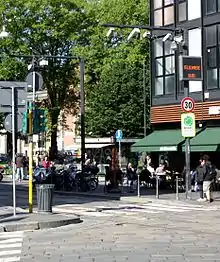
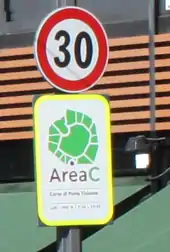
The objective of the program is to reduce traffic, promote public transport, and to decrease the high levels of smog in the city.[2] All net revenues from the system are used to promote public transport and sustainable mobility. Area C decreased vehicle entrances into the city by about 30%, increased average speeds of buses, and reduced levels of pollution.[3]
Background
Milan has one of the highest European rates of car ownership, as more than half of Milan citizens use private cars and motorcycles, ranking second only after Rome,[4] and among the highest in the world.[5][6] The city also has the third-highest concentration of airborne particulate matter among large European cities, both in terms of average annual level and days of exceeding the European Union limit of 50 micrograms per cubic metre of coarse particulates (PM10), according to a 2007 study supported by several environmental groups.[4] Due to its lingering air pollution problems and associated health problems, in 2007, and for a trial period, the city banned 170,000 older cars and motorcycles that do not pass strict environmental emission standards.[6]
In January 2008, the mayor of Milan, Letizia Moratti, launched the Ecopass program expecting a 30% cut in pollution levels and a 10% reduction in traffic.[5][7] The program imposed a charge on vehicles with higher pollution levels. Ecopass was an incentive for motorists to buy less polluting cars, and in a few years the number of cars with free access were the majority. Although these vehicles had less polluting engines, the free access helped less with the congestion problem. This trend contributed to a return to previous traffic levels and at the same time reduced revenue collected. This threatened the ability to keep the system in operation.[8]
Area C started as an 18-month pilot program based on the results of a 2011 referendum. The objective of the program was to drastically reduce the chronic traffic jams that take place in the city of Milan, to promote sustainable mobility and public transport, and to reduce the dangerously unhealthy smog.[2] Area C was definitively approved as a permanent program on 27 March 2013.[9]
Description
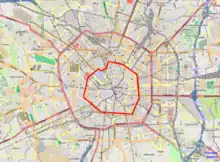
The congestion charge is based on the same designated traffic restricted zone or ZTL (Italian: Zona a Traffico Limitato), corresponding to the central Cerchia dei Bastioni area.[10] The ZTL encompasses about 8.2 km2 (3.2 sq mi) and 77,000 residents (4.5% and 6% of the city total, respectively).[11] The area is accessible through 43 gates, monitored by video cameras.
The charge applies to every vehicle entering the city centre on weekdays (Monday to Friday) from 7:30 am to 7:30 pm, except that Thursdays is free after 6 pm.[10] Every vehicle entering the charging zone must pay €5 regardless of its pollution level. Residents of the restricted area must also pay to reach their houses, but they have 40 free accesses per year and a discounted fare of €2.[12][13]
Access to the area is forbidden for diesel Euro 3 or below, gasoline Euro 0, and private vehicles over 7 m (23 ft) long.[14] Electric vehicles, motorcycles and scooters, public utilities' vehicles, police and emergency vehicles, buses and taxis are exempt from the charge. Hybrid electric and bi-fuel natural gas vehicles (CNG and LPG) were exempt until 1 January 2013.[12] This was later extended until the end of 2016.[15]
The program was temporarily suspended between 25 July and 17 September 2012 due to a ruling by the Council of State after protests by parking owners in the center of Milan.[16][17] After the suspension in summer 2012, the entrance in the area is free from 6 pm on Thursday.[16]
| Engine class → Euro levels → |
Gasoline | Diesel | Hybrid / bi-fuel | Electric | Scooters | ||||||||||||
|---|---|---|---|---|---|---|---|---|---|---|---|---|---|---|---|---|---|
| 6 | 5 | 4 | 3 | 2 | 1 | 0 | 6 | 5 | 4 | 3 | 2 | 1 | 0 | ||||
| non-residents | €5 | banned | €5 | banned | free1 | free | free | ||||||||||
| residents2 | €2 | €2 | free1 | free | free | ||||||||||||
| commercial | €3 | €3 | free1 | free | NA | ||||||||||||
| public service3 | free | banned4 | free | banned4 | free | NA | |||||||||||
1. until September 2022[18]
2. residents have also 40 free accesses per year
3. includes public transport, emergency vehicles, taxis
4. with exceptions
Chauffeur vehicles (Italian: Noleggio con conducente, NCC) with over 9 seats pay higher entrance fees, from €40 to €100, depending on the length of the vehicle.[18]
Results
Early results
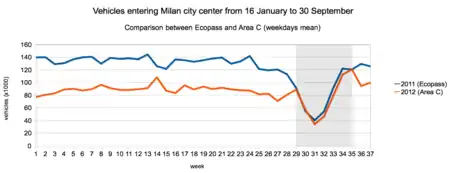
In the first month 33% fewer cars entered the city center: about 700,000 fewer vehicles during the month or about 40,000 per day.[19][20] A substantial decrease in traffic congestion in the restricted area was also reported, while traffic outside the area remained unchanged.[20] The congestion charge did not appreciably affect pollution levels, with the exception of the black carbon level, which decreased by about 30% in the ZTL.[19][20]
Data from the first two months showed that traffic also decreased outside the restricted zone: about 6% fewer vehicles outside the ZTL compared to the same months of 2011.[21]
The reduced congestion in the city center resulted in increased average speed for public transport, especially for buses and during peak hours. While there has been an increase of only about 3% in the whole day, the average speed in the morning peak hour (8-9 am) for surface public transport was about 10% higher than pre-Area C levels.[22]
The traffic reduction inside Area C restricted area since its implementation, compared to the same period of the previous year, was 34.3% by 30 April 2012.[23]:6 The total traffic reduction in the Milan area was about 7%[23]:8 By 30 September 2012, Area C had been operating for a total of 140 days (since 16 January).[24] During this period there was a decrease of 32.8% in vehicles entering the area, compared to 2011.[24]
Later results
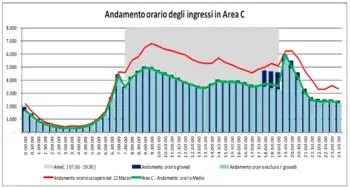
Later results confirmed the decreasing trend in traffic congestion in the city. In the first 6 months of 2015 the average number of cars entering the restricted area was 28.6% less than in the same period in 2011, during Ecopass.[25]
There were 21.6 million entrances to the restricted area in 2014 during the time of operation of Area C. Most drivers enter the restricted area only a few times a year, with about two thirds of cars entering 4 times or less during 2014. Moreover, most residents (71%) living inside the area did not use up all the 40 free permits a year.[26]
Taking into account an estimate for the willingness to pay for PM10 reduction, a study estimated that the welfare gain produced by Area C from air pollution reductions alone is $3 billion.[3] This is despite the fact that Milan's vehicle fleet is relatively clean compared to other cities in the world.[3]
Revenues
All net earnings from the scheme are invested to promote sustainable mobility and policies to reduce air pollution, including the redevelopment, protection and development of public transport, "soft mobility" (pedestrians, cycling, Zone 30) and systems to rationalize the distribution of goods.[9] In 2012, the program had a total revenue of about €20.3 million and net earnings after expenses of over €13 million. These resources were used to increase service on the Milan Metro, on surface public transportation network and to finance the extension of the BikeMi bike sharing scheme.[27]
Criticism and controversies
Area C, like its predecessor Ecopass, came in for a lot of criticism, especially from right-wing politicians. Demonstrations were held against Area C and an item of hate mail containing a bullet case and text against the congestion charge was sent to the mayor Giuliano Pisapia.[28]
Opponents called for a referendum to abolish Area C,[29] but failed to reach the minimum number of signatures to propose it.[30]
Protests by owners of car parking in the center, who had seen a decrease in profits, led to a ruling by the Council of State which suspended the program on 25 July 2012 for further investigations of its legitimacy. Area C was reactivated on 17 September of that year.[16]
Area B
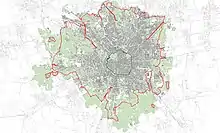
Area B is a larger restricted traffic zone, which came into force on 25 February 2019.[31] It was introduced to restrict access to the city to the most polluting vehicles and to large vehicles.[32]
See also
Similar congestion pricing schemes
References
- Martino, Angelo. "Milano: from pollution charge to congestion charge" (PDF). Archived from the original (PDF) on 4 October 2015. Retrieved 17 January 2012.
- "La "nebbia metropolitana" che avvelena la vita in città". la Repubblica (in Italian). 26 December 2011. Retrieved 24 December 2020.
- Gibson, Matthew; Carnovale, Maria (September 2015). "The effects of road pricing on driver behavior and air pollution". Journal of Urban Economics. 89: 62–73. doi:10.1016/j.jue.2015.06.005. Retrieved 5 April 2017.
- Marco Bertacche (3 January 2008). "Milan Introduces Congestion Charge To Cut Pollution". The New York Sun. Retrieved 15 February 2009.
- Antonella Ciancio (2 January 2008). "Milan drivers face trend-setting pollution charge". Reuters UK. Retrieved 24 February 2009.
- Mark Duff (1 February 2007). "Smog-hit Milan tests vehicle ban". BBC News. Retrieved 18 February 2009.
- BBC News (2 March 2008). "Milan introduces traffic charge". Retrieved 15 February 2009.
- Gianni Santucci (12 January 2009). "Cede l'effetto-diga, 7 mila auto in più" (in Italian). Corriere della Serra. Retrieved 24 February 2009.
- "Area C. Istituita la congestion charge definitiva". Comune di Milano. Retrieved 13 May 2013.
- "Area C è partita: calate del 40% le auto in centro dopo l'entrata in vigore del pedaggio" [Area C takes off: auto traffic decreased 40% in the center after the toll goes into force]. Corriere della Sera Milano (in Italian). 16 January 2012. Retrieved 16 January 2012.
- Martino, Angelo. "Milano: from pollution charge to congestion charge" (PDF). Archived from the original (PDF) on 4 October 2015. Retrieved 17 January 2012.
- Rosario Mastrosimone (27 December 2011). "Congestion charge Milano: Area C, tariffe, divieti, esenti" [Milan congestion charge: Area C, tariffs, prohibitions, exemptions] (in Italian). Sostenibile. Retrieved 16 January 2012.
- Teresa Monestiroli (18 December 2011). "Pisapia lancia l'operazione Area C l'obiettivo: -20 per cento di traffico" [Pisapia launches Area C program with a target: reduce traffic 20%]. Corriere della Sera Milano (in Italian). Retrieved 16 January 2012.
- "Scheda riassuntiva Area C" [Summary Sheet Area C]. Corriere della Sera (in Italian). 16 January 2012. Archived from the original on 19 January 2012. Retrieved 16 January 2012.
- "Regolamentazione accesso". Comune di Milano. Retrieved 10 April 2014.
- "Area C, torna il ticket anti traffico da 5 euro Al giovedì telecamere spente alle 18" [Area C, the 5 euro ticket is back. Cameras off at 6 pm on Thursday]. Corriere della Sera (in Italian). 14 September 2012. Retrieved 28 October 2012.
- "Area C, dal 17 settembre riparte la sperimentazione per 6 mesi" [Area C, the program is reintroduced from 17 September for 6 months] (in Italian). Comune di Milano. Retrieved 28 October 2012.
- "Area C: FAQ". Portale del Comune di Milano (in Italian). Retrieved 4 May 2019.
- Santucci, Gianni (16 February 2012). ""Area C", si paga anche con il Telepass "Tolte" 700 mila auto" [Area C, payment with Telepass also available, 700 thousand cars less]. Corriere della Sera Milano. Retrieved 17 February 2012.
- "Area C, in un mese 700.000 auto in meno E ora si può pagare anche con il Telepass" [Area C, 700,000 cars less in a month, and now payment by Telepass is available]. la Repubblica. 15 February 2012. Retrieved 17 February 2012.
- "Il primo bilancio di Area C un'auto su sette non paga". la Repubblica. Retrieved 24 March 2012.
- "Prime valutazioni degli effetti sulle velocità commerciali dei mezzi pubblici di superficie" [Expected results and monitoring: Early results on surface public transport commercial speed]. Risultati attesi e monitoraggio. Comune di Milano. Retrieved 24 March 2012.
- "Sintesi risultati al 30 Aprile 2012". Risultati attesi e monitoraggio. Comune di Milano. Retrieved 25 May 2012.
- "Sintesi risultati traffico - Gennaio-Settembre 2012". Risultati attesi e monitoraggio. Comune di Milano. Retrieved 28 October 2012.
- "Sintesi risultati al 30 Giugno 2015". www.areac.it. Comune di Milano. Retrieved 5 October 2015.
- Carra, Ilaria (17 January 2015). "Milano, finito l'effetto Area C nel 2014 gli accessi in centro sono ritornati a crescere". la Repubblica. Retrieved 5 October 2015.
- "Bilancio Economico Area C". Comune di Milano. Retrieved 17 July 2013.
- "Area C, busta con un bossolo indirizzata a Pisapia intercettata dai carabinieri" [Area C, a letter with a bullet for Pisapia intercepted by the Police]. Corriere della Sera (in Italian). 17 January 2012. Retrieved 17 January 2012.
- Masseroli, Carlo. "Un referendum contro l'area C" [A referendum against Area C]. Corriere della Sera (in Italian). Retrieved 20 January 2012.
- "Area C, niente referendum il Pdl fa un flop sulle firme". Corriere della Sera. 18 May 2012. Retrieved 19 May 2012.
- "Milano - AR". urbanaccessregulations.eu. Retrieved 4 February 2019.
- "Area B: cos'è e come funziona". Portale del Comune di Milano (in Italian). Retrieved 4 February 2019.
External links
| Wikimedia Commons has media related to Milan Area C. |
